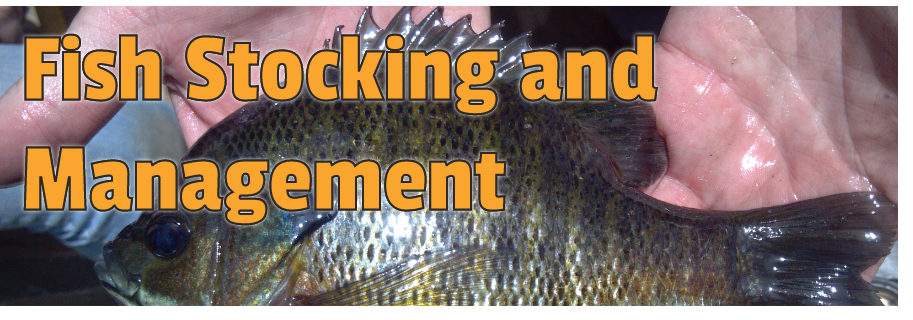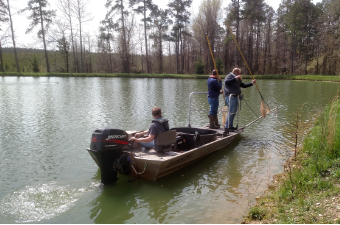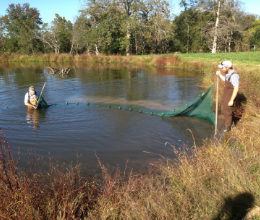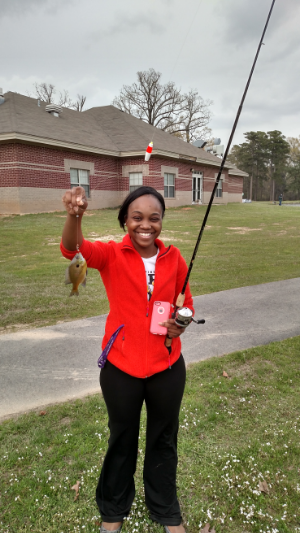Main Content

Fishery Assessment
The easiest method to assessing the condition of your fishery is to hire a pond management company to perform an electrofishing survey.
|

|
Benefits of electrofishing surveys:
- Rapid results
- Comprehensive fish sampling
- Company can harvest undesirable / underperforming fish immediately
- Reports will explain the situation and what must be done to improve the fishery
Drawbacks of electrofishing surveys:
- Can be expensive
- May not be practical in small ponds
- Not all fish species are sampled equally well
- Not a very successful sampling method for open or deep water
- Few local service providers in Arkansas (currently) |
The biggest selling points for electrofishing surveys is that they can be completed in a single day and they collect all sizes of most species from the very large to the very small equally well. Additionally, the company will usually provide you with a sampling report that explains the condition of the fishery with guidance on how to improve it. These companies can also simply perform the management for you for an additional charge. The biggest drawbacks of electrofishing surveys is that they are expensive and they don't collect fish from deep or open water very well. Electrofishing is most effective when the fish can be corralled close to the bank in shallow water. Pond management companies offering electrofishing surveys are easily found online, or you can contact county Extension agents for guidance on locating providers.
There are effective methods to assessing pond fisheries on your own. This can be partially done with rod and reel fishing or with seine net sampling by themselves, but the assessment is more complete and stronger when the two methods are combined.
Benefits of assessing the fishery on your own:
- Very low financial investment
- The "sampling" is fun!
- If you need to ask fisheries specialists for guidance, your data is valuable information
- Changes to the fishery are more easily detected with regular fishing than annual electrofishing samples
Drawbacks of assessing the fishery on your own:
- Requires more time and physical investment
- Requires some study, record keeping and data interpretation
- Habitat or pond conditions may render seine net sampling impossible
- May be difficult to get representative samples in large ponds / lakes |
 |
Assessing the fishery yourself can save a great deal of money and with minor study time to understand some basic principles, it is usually not difficult to diagnose what is going on with the population. Even if the data you collect doesn't make sense, you can relay that data to a fisheries specialist and together you can work out the problem more easily than if the data did not exist. This method does require more work on the part of the pond owner/manager, and it can take some time to collect enough data for a clear picture of the fishery. Additionally, this method requires some detailed notes and record keeping which can make fishing feel more like work than fun. However, with practice you will start to see signs of fishery dysfunction more quickly without having to refer back to published resources for guidance.
Skills and supplies needed:
- Two people for seining
- Ability to identify both adult and juveile largemouth bass and bluegill
- Ability to drag heavy weights while in water
- Waders (if desired)
- Life vests (strongly advised)
- Digital camera to document unknown species for identification later
- Data sheets with pencils
- Seine net (20 feet long by 4 to 5 feet deep with 3/8-inch diameter mesh)
- Holding buckets / tanks with aeration (optional)
- Measuring board or ruler (range of 0 to 20 inches in length at least)
- Weight scale (range of 0 to 10 pounds at least)
- Fishing rods and tackle (gear appropriate for fishing for both small and large bluegill and largemouth bass)
- Dip net
How to do it:
 |
To get the full picture of what is going on in the fishery, it is best to combine seine net sampling with rod and reel fishing. The goal of the seine net is to measure reproduction by capturing larval and juvenile fishes, not adults. Therefore, it's best to wait until the water is at least 75 degrees consistently as most pond species should be done spawning or in the process. Two people are needed when seining, with one dragging the net along the water's edge on the bank and the other pulling the net parallel to the first person but 10 to 12 feet out into the pond. A third person can follow behind the net to help clear it from obstructions if it becomes snagged. Be sure that the weighted bottom line of the seine maintains contact with the pond bottom and that there is a bow in the seine as you drag it 20 to 30 feet down the bank. Drag at a steady speed to maintain the bow in the seine and so that fish cannot easily swim out. At the end of the seine haul, the person out in the water should begin circling towards the bank while the person on the bank holds their position. Once both people are at the bank, begin slowly pulling the seine on shore from both ends, always maintaining contact between the pond bottom and the bottom line of the seine. Once the bottom line of the seine is at the bank, you can use a dip net to scoop several fish from the basket created between the seine float line and the bottom line. Try to work quickly at this point, the shallow muddy water can be stressful on the fish. Ideally, the fish can be transferred to aerated buckets or large tanks filled with pond water for processing. Record the number of each species caught and the lengths of bluegill and largemouth bass. Return the measured fish back to the pond as quickly as possible.
Sampling with rod and reel is more straight forward, simply use a fishing rod with appropriate hooks and lures to catch small to large largemouth bass and bluegill. Record the amount of time fished, the number of each species caught, and take length and weight measurements of largemouth bass and bluegill. |
It is not necessary to seine the entire pond, and you don't have to catch every fish in the pond for a representative sample. There is no set standard for how many to catch but in general, 100 to 200 fish caught in the seine and 25 or more largemouth bass and 25 or more bluegill caught by rod and reel should be enough to start seeing reasonable averages.
Once you have collected seine and fishing data, compare your results with the table below:

Fishery Management
Fishing ponds require harvest to maximize their potential. This concept cannot be overstated. The majority of fish population problems in ponds today are derived at least partially from not harvesting enough, or any, fish. General harvest recommendations are provided in the table below. As with stocking, these harvest rates can and should be increased if the pond is fertilized or if feed is provided regularly. Harvest rates vary depending on the goal of the owner, so if you are pursuing trophy largemouth bass, trophy bluegill, or have stocked species other than the traditional bluegill, largemouth bass and catfish strategy, contact a fisheries specialist for guidance on harvest rates.

Balance is a commonly used term to describe the equilibrium between largemouth bass and bluegill populations in a pond. A balanced pond is one where both largemouth bass and bluegill populations have stable reproduction each year and there is a range of sizes from small to large in both species. Essentially, bluegill are providing enough food for the largemouth bass, and the largemouth bass are keeping the bluegill population under control.
Ponds lacking appropriate harvest of largemouth bass often end up overcrowded by largemouth bass. These ponds are full of small hungry largemouth bass and few, but often very large, bluegill. When largemouth bass overpopulate, bluegill are eaten before they can grow more than 2 to 4 inches long. The lucky few bluegill that somehow evade largemouth bass long enough to outgrow their mouths can grow to very large sizes. These ponds are usually very entertaining to fish because the hungry largemouth bass are easy to catch, and the few bluegill that are available are very large. However, if bigger largemouth bass are desired, simply harvest up to 35 pounds of largemouth bass less than 13 inches long per acre per year until average size improves. Once a desirable average size has been achieved, return to the standard harvest rate of about 10 to 15 lbs of largemouth bass per acre per year less than 13 inches.
Ponds lacking enough predators can become overcrowded with bluegill. These ponds are full of 2 to 4 inch bluegill and very few, but often very large, largemouth bass. When bluegill overpopulate, they devour anything they can eat, including recently hatched largemouth bass. The few largemouth bass that do survive grow very slowly because the bluegill are consuming the same food items that small largemouth bass need. The even fewer largemouth bass that somehow get large enough to start eating the stunted bluegill can then grow very quickly because they have an abundant food supply and little competition. These ponds can be enjoyable for largemouth bass enthusiasts who are more interested in the size of fish caught than the number of fish caught. However, beginners and casual anglers may find these ponds frustrating because there are fewer fish to catch and the bigger largemouth bass tend to be more difficult to catch. Returning bluegill crowded ponds to a balance can be challenging, but there are options. A combination of removing every bluegill caught while fishing and one or more of the following methods can help correct bluegill crowding:
1. Reduce the pond volume by half in the late summer to early fall. Allow the pond to refill over winter. This approach concentrates the bluegill so that the largemouth bass can eat them easier. If a built-in pond drain is not available, a diagram of a home-built siphon drain is provided below. Water pumps can also be rented from local equipment vendors to drain the pond.
2. Stock 20 to 30 adult (8 to 14 inches long) largemouth bass per acre. The additional largemouth bass will help reduce the bluegill population.
3. If all else fails, completely drain the pond and kill all of the fish. Restock the pond after it refills at least half way with the appropriate ratios of fish and harvest fish as recommended. This is also the best option when the pond is overrun with undesirable species, such as bullhead catfish and green sunfish.
Restoring an unbalanced pond through corrective harvest and supplemental stocking can take years to achieve the desired results. In some cases, the fish populations are too unbalanced to be restored through corrective harvest and supplemental stocking alone. In these cases, draining the pond, killing all of the fish, and restarting from scratch is the best solution. This strategy can create good fishing within 2 to 3 years, depending on the species stocked.
What to read next:
-
Starting Over